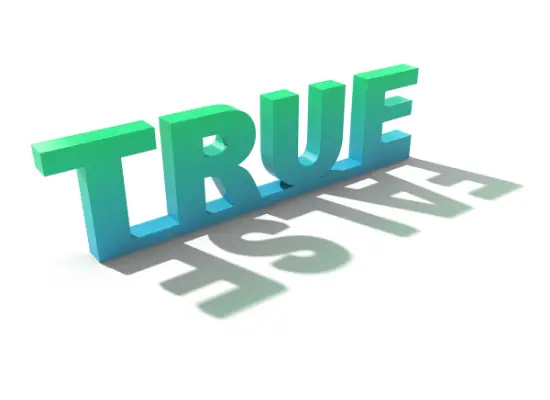Many teachers love to put true or false questions on tests because they are easier to formulate when making up tests. Many students prefer them to having to fill in the blank or essay questions, mostly because they are quicker and less risky. It seems to be almost universally preferred. But whether they are really a beneficial part of test-taking is an issue worth looking into.
So then, the ultimate question is SHOULD teachers be using true or false questions on their quizzes and tests? The short answer is that it should certainly not constitute the majority of a test or quiz, but can be used effectively to help students reason through some of the material. That puts a large onus on the teacher or test writer to make sure that the questions are well worded, clearly understood, and not “tricky” in any way.
That is very difficult to do, especially when each student thinks in a different way and may not see things in the same way that the test writer and may not be able to discern the answer as easily as the test writer expected. Let’s take a look at some of the pros and cons, as well as some of the ways to make true or false questions work better on their tests.

Table of Contents
Advantages of True or False Questions
1. They are quick to formulate.
This is clearly the teacher’s advantage. It is definitely beneficial for the teacher to think of a handful of basic facts (s)he wants the students to know offhand and quickly put them into true/false statements that will be easy for students to grasp and answer quickly.
This is the perfect format for facts that don’t have any wiggle room for interpretation.
2. Students can answer them quickly.
Students will not generally spend very much time on a true or false question, even if they are not sure about the answer. They will read the question, and if they know it, they will answer immediately. If they don’t, they will probably read through it a couple more times to try to get a clearer understanding of the question before coming to an answer.
If at that point, they are still unsure of the answer, they will weigh their options and then generally guess to the best of their ability before moving on. It is almost never a format that will cause a student to stop for a while to figure out the right answer.
3. They can cover a large amount of material.
When teachers ask several true or false questions (5-10), it allows them to move significantly through the material being tested on. Some of the best true or false sets cover the content systematically in a way that allows the student to move throughout the questions in a consistent progression of thought as the content was presented.
This is actually one of the best ways to test students, as it allows them to revisit discussion as they moved through the material in class. It is a great way to help them remember processes or timelines.
4. They are easy to grade.
It doesn’t get much easier than finishing the test, then telling students to exchange papers so they can mark the right/wrong answers accordingly. Then teachers will only need to quickly go over papers before putting the final grade on them.
No worries about evaluating answers and/or giving partial credit for answers that got sort of close to the concept being taught/tested on.
5. They can be made as simple or complex as you need for your students’ needs.
If you are teaching a certain class to multiple groups of students, you can cater them to the specific needs of those students, especially if classes are split up according to ability.
The questions can still be based on the same facts or material, but you can adjust the vocabulary and any additional information that will allow the students to reason out the answer to the best of their ability. This is a great way to reach out to students and encourage them to push just a little further in their level of knowledge.

Disadvantages of True or False Questions
1. They are considered one of the most unreliable forms of testing.
The reason for this is because true or false questions are notorious for students guessing at the answers rather than taking the time to answer them thoughtfully.
One way to combat this problem is to later reference the true or false questions in a short answer or even multiple choice question later. It will allow the student to revisit the information they have learned and put more thought and a better answer to the question they already answered.
This is actually a great way to reinforce what they have already learned.
2. They can be used intentionally or unintentionally to trick students.
The biggest reason for this problem is that teachers can think that they worded the true or false questions well, but upon students reading them, find that they were actually more confusing than intended.
One of the best ways to remedy this issue is to have a fellow teacher look it over to make sure everything is worded clearly and succinctly. If a teacher is not available, a spouse or friend may be able to help. Just getting a second pair of eyes on it will be a great help.
3. They can be confusing to students.
Many students see the true or false section of a test and automatically think there is a trick involved. So they will either spend too much time trying to find the one word that changes the whole question to a trick question or they will just guess at the answer because they feel too much pressure to think their way through it.
On the other hand, other students will see the true or false section of a test as a challenge to find that one tricky word.
But what if there isn’t a tricky word and the questions are straightforward and well worded? In that case, students may have an easier time of getting through it without worrying about “ulterior motives.”
A great way to ease your students’ minds regarding this is to put a note in the instructions letting them know that there are no tricks and not to spend too much time over-evaluating.
4. They can cause students to stop thinking and just start guessing.
Students who are already feeling the pressure of time will gloss over the questions and feel defeated about having the time to figure it out, especially if they think there is any tricky aspect to it.
My recommendation here is to make sure that students realize there is no tricky aspect and that they do have time to evaluate the question before attempting to answer. Putting their minds at ease is a great way to help them gain confidence in test taking.
5. They can make it hard to accurately assess students’ level of knowledge.
When asking short answer or essay questions, it is much easier to see exactly what the students have mastered of the material. Even in multiple choice questions, teachers see the thought processes of the students as they answer the questions either correctly or incorrectly.
But the problem with true or false questions is that teachers don’t know if the student answered the questions based on knowledge or a guess. Teachers also can’t gauge if students had incorrect understanding of the material.
At the end of the day, while teachers can use the answers given to assign a grade, they cannot verify any material that has been mastered or missed.
How to Make Effective True or False Questions

1. The fewer words, the better the question.
Students will easily get caught up with heavy wording of true or false questions, especially if they are not confident test takers. This especially pertains to students who have had experience with tests that did have tricky true or false questions.
Keeping the wording simple will help students not feel that they have to sift through so much to get to the actual meaning of the sentence.
Also, using very specific words is helpful because they won’t have to worry about not understanding the exact meaning of the words being used.
So, bottom line: fewer words with very specific meanings are best. This seems like such an easy concept, but sometimes when writing tests, we forget to keep it that simple.
2. Don’t use double negatives or other confusing language.
As soon as teachers start using double negatives, students start trying to figure out where the trick is. The complex language and concepts automatically feel confusing and tricky. And then once they start second guessing themselves, they will feel defeated about the test they are trying to do well on.
Confusing language will also produce the same effect. Once students feel like the question is over their heads, they will be checking out and randomly choosing an answer.
3. Don’t fill the questions with details.
The more details students have to figure out, the harder the question will be to answer. Try to keep the statement at one or two major facts with few adjectives and adverbs (or even none) so students don’t have to sift through too much information to get to the answer they are looking for.
4. Only cover one idea or concept per question.
This continues the point of the previous couple of suggestions. Keeping things simple will allow students to read the question, evaluate its truth or falsehood, and answer accordingly.
Students that are able to answer true or false questions in this way will gain great confidence in their test taking skills. What better gift can we give to our students than the ability to learn to do well on their tests!
5. Be careful to only use “black and white” facts.
If you use facts that are even a little bit subjective, students will have a hard time discerning whether the statement is true or false.
While this does tend to make the questions easier to answer, the point of true and false isn’t to fool students into answering incorrectly. And because of the fact that true/false questions really aren’t the best way to measure student mastery, these questions necessarily aren’t going to be very profound anyway. We definitely shouldn’t be reaching for the stars with this testing medium.
What Not to Do With True or False Questions on Tests
1. Don’t use concepts that are open to interpretation.
When you use concepts that are open to interpretation, you will have issues with students having valid reasons for their answer being different than the answer you intended.
That is fine if you don’t mind engaging with the student(s) later to find out their reasoning for why they came up with the answer they did. If they can give you a reasonable argument as to what they were thinking, they can gain the credit for a correct answer.
This would actually turn this point into an advantage rather than disadvantage because it helps students to give an answer as to why they think the way they do about the information being presented to them.
However, it may not be the best format to have this sort of engagement, since true/false questions are meant to pass through quickly without a ton of thought behind them.
2. Don’t lean too heavily on either true or false answers.
If you have too many of either true or false answers, students will start second guessing whether they are answering correctly, and then they may start answering incorrectly to balance what doesn’t seem to be consistent in their minds.
It is good to have pretty close to a good balance between true and false. Don’t worry about it being exactly equal, just not tilted too heavily either way.
3. Don’t use statements exactly as written in the textbook.
When you use statements exactly as written in the textbook, students will not be paying attention to the facts as much as trying to remember the location on the page, or something in particular that they learned. That isn’t necessarily a bad thing. I mastered many tests by pulling the location of the facts in textbooks up from my memory.
But once again, with the true or false format, it is better for the student to read the question at face value and pretty much automatically have an idea of which way they intend to answer.
4. Stay away from superlative language.
Superlative language tends to go to extremes that most true or false questions were never meant to go to. Because of this, students will likely automatically want to answer that the statement is false because there are rarely times in life that the superlative is the rule rather than the exception.
5. Don’t make patterns with the answers.
When you make patterns with the answers (for example, T,T,F,F,T,T…) students will either pick up on them and finish without even reading the questions. Or they will start second guessing their answers and be less attuned to the statements and more toward making their answers look a certain way.
Especially be careful not to inadvertently start a pattern that doesn’t continue. That could be disastrous to your students’ potential answers if they pick up a pattern and use it, not getting a large number of questions right because of it.
Conclusion
This has been my experience with using true or false questions on tests. I do still use them on occasion, though it is not the norm for my test writing practices.
They can indeed be an effective tool for evaluating master of the material. But they do take more effort than it would seem at first in order to make sure they are a benefit to the test and not a drawback.
The one final thought I would like to leave with is that one of the best things a teacher can do is to spend time near the beginning of the year letting students know his/her testing methods and how she expects students to approach/respond to the way they are written. You will be amazed at how much that will improve your students’ grades because they will know what your intentions are and what you expect for them to learn and know.
What has been your experience with using true/false questions in your tests? How have your students responded? Let me know in the comments below!




